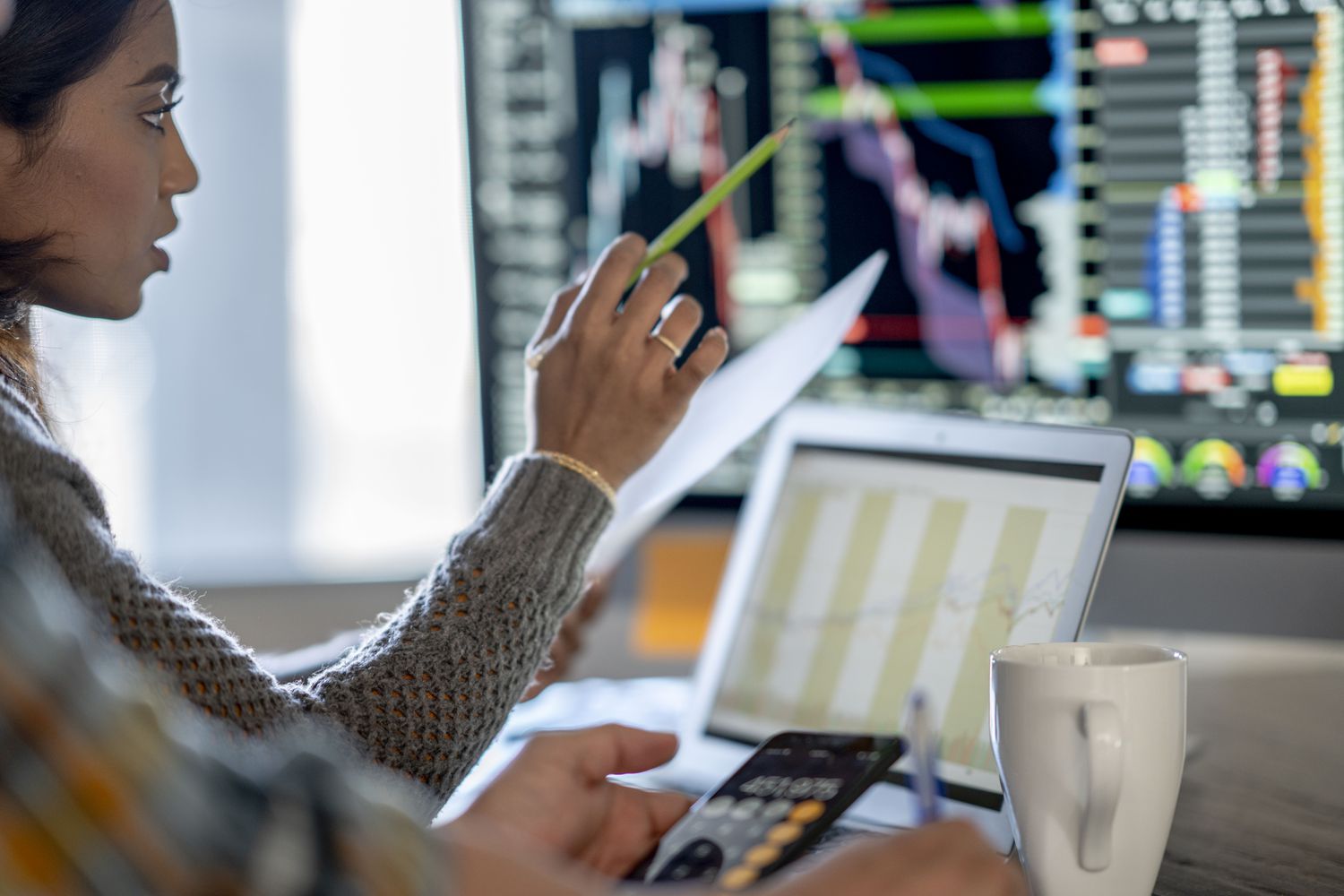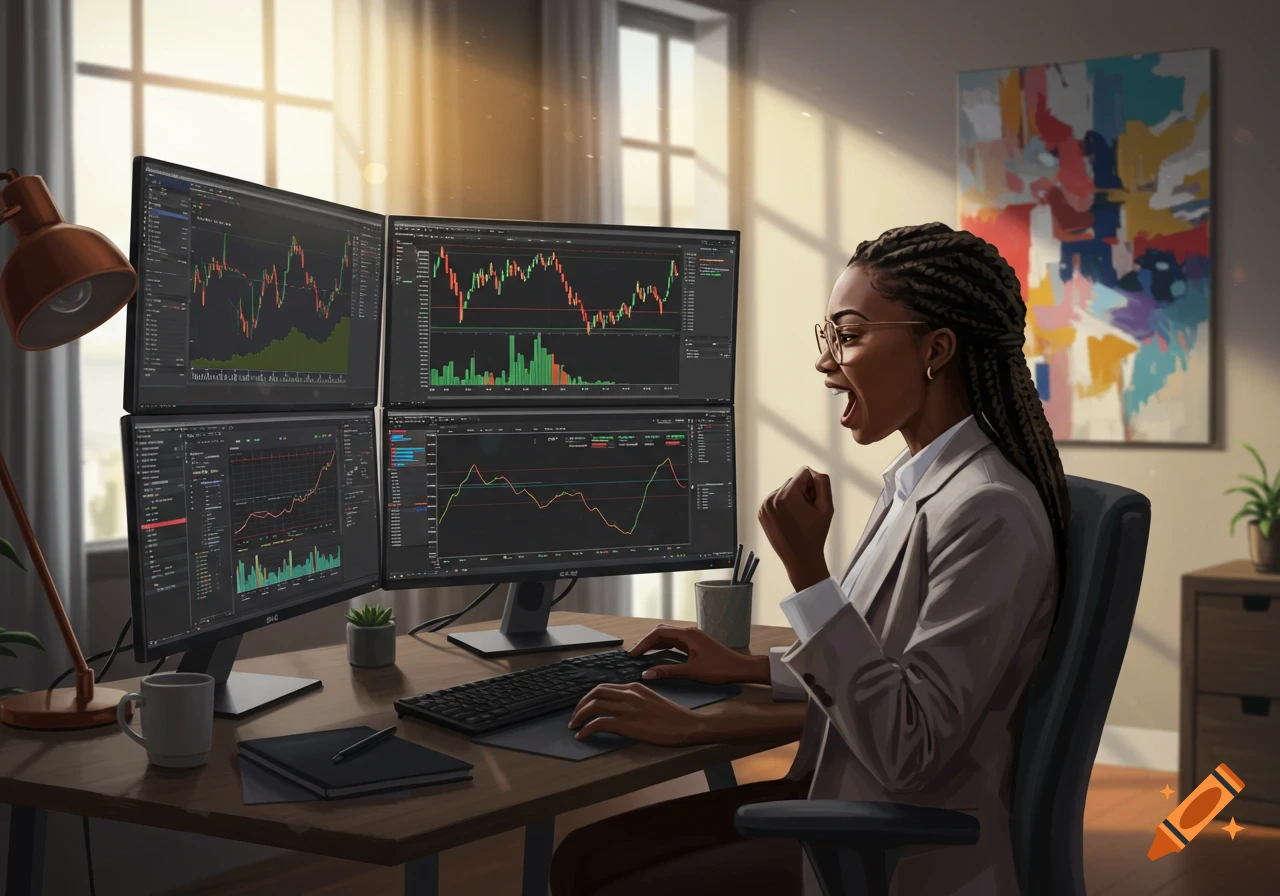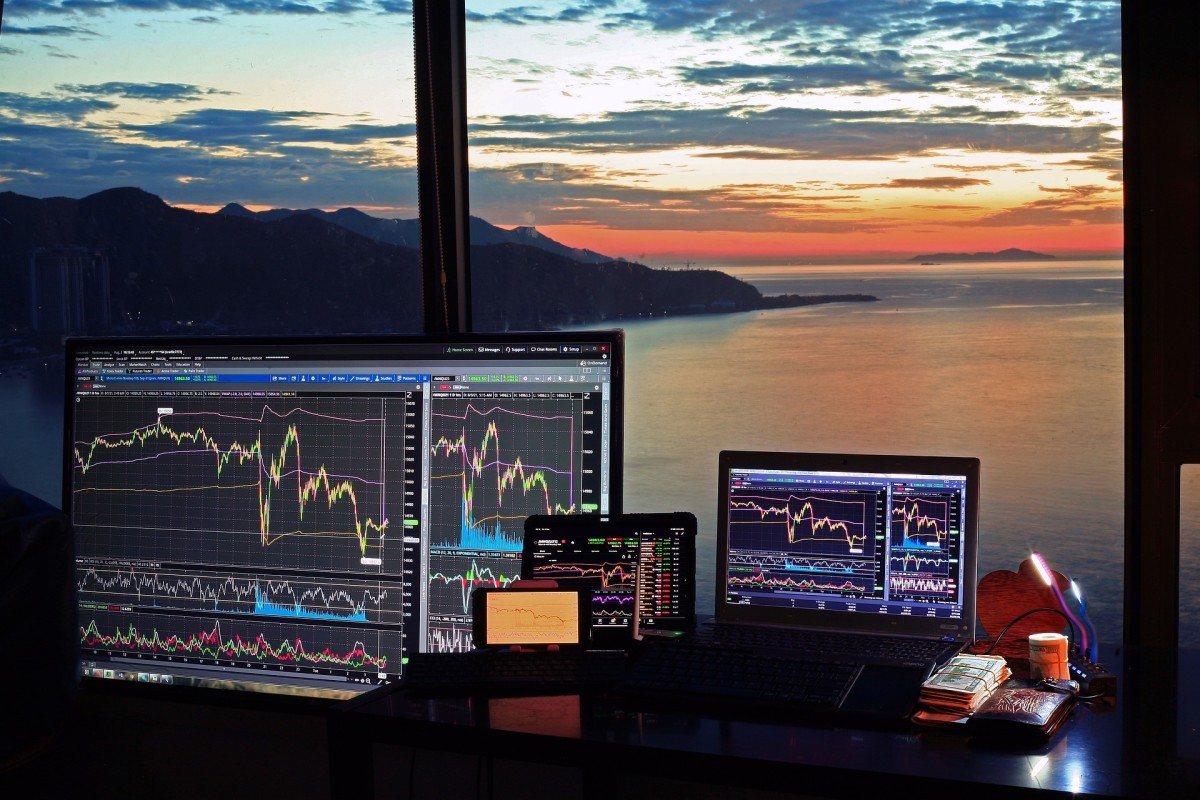You sit at your screen as the market opens, watching price swings and wondering which venues give you the clearest signals and the best chance to profit. Day Trading Tips often emphasize liquidity, volatility, tight spreads, and reliable trading hours as key factors. This guide compares stocks, forex, futures, indices, commodities, and cryptocurrencies, examining volume, slippage, execution speed, and costs to help you clearly identify which markets offer the best opportunities for day trading. Which market fits your time zone, risk tolerance, and strategy?
If you want to pick the right market for your style and time zone, Goat Funded Trader, a prop firm, helps by offering funded capital, simple rules, and market access, allowing you to test strategies at scale without risking your personal account.
7 Best Markets for Day Trading

1. Stock Markets for Day Trading
The stock market remains one of the most favored arenas for day traders worldwide. The concept is straightforward: traders buy and sell shares of publicly listed companies within the same trading day, aiming to profit from short-term price movements. The attraction lies in the accessibility to some of the world's most renowned firms, such as Amazon, Google, Shell, and BP.
Day traders can choose from several major stock indices, each with distinctive features:
FTSE 100
Comprises 100 of the largest companies listed on the London Stock Exchange.
Dax 40
Includes 30 significant German companies listed on the Frankfurt Stock Exchange.
Hang Seng
Features 50 companies ranked by market capitalization on the Hong Kong Stock Exchange.
NASDAQ Composite
Packed with leading technology companies.
S&P 500
Lists 500 of the most widely traded stocks in the U.S.
Dow Jones Industrial Average
Contains 30 of the largest and most influential U.S. companies.
The stock market provides numerous tools and resources for day trading, including educational courses, forums, blogs, and live screeners, which aid traders in making informed decisions.
Key Considerations
- Despite immense opportunities, the stock market is characterized by fierce competition and stringent regulatory requirements.
- U.S. day traders typically require a minimum of $25,000 in their trading accounts to comply with pattern day trading rules, which can present a barrier for beginners or those with limited capital.
- Stock markets operate during fixed hours, which might restrict flexibility in trading times.
2. Forex Markets for Day Trading
The forex market is the world's largest and one of the most dynamic markets available today. It involves the buying and selling of currencies in pairs, aiming to profit from fluctuations in exchange rates. Unlike stock markets, forex trading operates 24 hours a day, 5 days a week, providing flexibility for traders around the clock.
Currencies are always traded in pairs, such as the popular EUR/USD or GBP/USD, which offer high liquidity and volatility suitable for intraday trading. Traders take long or short positions depending on whether they anticipate the currency will strengthen or weaken relative to its counterpart. Forex trading is highly accessible, requiring minimal initial capital, often as low as $100 to $1,000, and typically incurs no commission fees, as brokers generate revenue from spreads.
Key Considerations
- Trading Hours: Forex markets operate 24/5, enabling trades to fit around other commitments.
- Volatility: Price fluctuations offer opportunities but require attention to market sessions with higher activity, typically during overlapping market hours.
- Leverage: Many traders use leverage to amplify gains, though this also increases risk.
- Strategy: Popular strategies include scalping, trend trading, breakout trading, and news-based trading, all of which require a firm grasp of technical analysis.
3. Cryptocurrency Markets for Day Trading
The cryptocurrency market has emerged as a highly popular domain for day traders due to its unique characteristics. Crypto day trading involves buying and selling digital currencies within the same trading day to capitalize on rapid price changes. Unlike traditional markets, cryptocurrency markets operate 24/7, without closing hours or weekends, offering continuous trading opportunities.
Key digital currencies favored by day traders include Bitcoin, Ethereum, Litecoin, Ripple, Stellar, and Dash. These markets are known for their pronounced volatility, creating more chances to profit from intraday price swings. The availability of numerous cryptocurrencies and trading platforms, along with relatively low entry costs, makes it accessible for many traders.
Key Considerations
- Volatility: Crypto markets experience significant price fluctuations, providing numerous trading opportunities but also heightened risk.
- Accessibility: Minimal capital is required to get started, and many platforms offer free trading tools, tutorials, and real-time data.
- Risk Factors: Exchange security risks and the potential for market manipulation require traders to exercise caution and employ robust risk-management strategies.
- Trading Strategies: Popular strategies include scalping, momentum trading, breakout trading, and range trading, often supported by technical analysis indicators.
4. Futures and Commodity Markets for Day Trading
Futures and commodities markets provide a unique day trading experience centered on raw materials, including metals, energy resources, agricultural products, and other tangible goods. Traders speculate on the price movements through futures contracts, which are agreements to buy or sell assets at a predetermined price and date in the future. This type of market provides opportunities to profit from short-term price volatility in commodities such as oil, gold, natural gas, and agricultural products.
Commodity markets operate nearly 24 hours on weekdays, allowing day traders to respond swiftly to global market events. They also serve as a means for diversification and inflation hedging in investment portfolios.
Key Considerations
- Contract Specifics: Each futures contract has its own specifications, including trading hours and expiration dates. Traders must exit positions before contracts expire unless they want to take or make physical delivery.
- Market Volatility: Commodity prices are influenced by supply and demand, geopolitical events, weather conditions, and economic data, causing frequent price swings that are ideal for day trading.
- Trading Strategies: Popular approaches include scalping for quick, small profits, trend trading by following market directions, and range trading within specified price zones.
- Capital Requirements: Futures trading requires a moderate capital outlay, with brokers typically requiring a margin of several thousand dollars.
5. Options Markets for Day Trading
Options are financial derivatives that grant the holder the right, but not the obligation, to buy or sell an underlying asset at a predetermined price within a specified timeframe. Trading options allows day traders to speculate on stock price movements without owning the actual stock, often requiring less capital than stock trading.
There are two types of options. Call options give the right to buy at a specified price, and put options give the right to sell at a specified price. These contracts can cover a variety of assets, including stocks, indices, futures, and ETFs. Options trading offers flexibility and leverage, which can lead to higher profit potential but also bring increased risk.
Key Considerations
- Cost-Effective: Compared to purchasing stocks outright, options can be more affordable with potentially high returns.
- Leverage: Investors can control prominent positions with a smaller amount of money.
- Risk Management: Options can be used to hedge other investments, providing strategic versatility.
- Expiry and Volatility: Options have expiration dates, which require careful timing and understanding of market volatility.
6. Binary Options Markets for Day Trading
Binary options represent a type of financial derivative where traders predict whether the price of an asset will be above or below a specific level at a particular time. This market is distinct because trades have only two possible outcomes: either a fixed profit or a complete loss of the initial stake, making it an "all or nothing" betting style.
Despite the simplicity, binary options carry significant risks due to their all-or-nothing nature and require disciplined risk management strategies. Their appeal lies in the clear outcomes and straightforward decision-making process.
How Binary Options Work
- Traders select an underlying asset, such as stocks, foreign exchange (forex) pairs, commodities, or indices.
- They select an expiration time ranging from seconds to hours.
- A direction is chosen: "call" if the price is expected to rise, or "put" if it is likely to fall.
- If the prediction is correct at expiration, the trader receives a predetermined payout, often around 70-80% of the investment. If wrong, the entire investment is lost.
Key Considerations
- Simplicity: Binary options are easier to understand compared to traditional options, making them accessible to beginners.
- Risk Management: The fixed risk on each trade helps control potential losses.
- Short-Term Focus: Trades are typically short-term, lasting from a few minutes to a few hours.
- Market Variety: They can be traded on various markets, including forex, stocks, and commodities.
7. Contracts for Difference (CFD) Markets for Day Trading
Contracts for Difference (CFDs) are financial derivatives that enable traders to speculate on the price movements of various assets, such as stocks, commodities, indices, and foreign exchange (forex), without owning the underlying assets. When trading CFDs, you enter a contract with a broker to exchange the difference in the asset's price from the time the trade opens to when it closes.
With CFDs, traders can take a position based on whether they believe the asset's price will rise (buy/long) or fall (sell/short). The profit or loss depends on the difference between the contract's opening and closing prices. CFDs are typically traded on margin, meaning traders only need to put up a fraction of the total trade value, allowing for leveraged exposure.
Key Considerations
- Risk of Leverage: While leverage can boost profits, it can also magnify losses, making risk management crucial.
- Spread Costs: Brokers typically earn through spreads (the difference between buy and sell prices), which impact trade profitability.
- Regulation and Safety: CFDs are not permitted for retail traders in certain countries (e.g., the US), so selecting a reputable and regulated broker is crucial.
- Demo Accounts: Many brokers offer demo accounts for practice before committing real funds.
Related Reading
- Can You Make Money Day Trading
- How Old Do You Have to Be to Day Trade
- Options Trading vs Day Trading
- Day Trading Success Stories
- Day Trading Crypto vs Stocks
- Day Trading Psychology
- Day Trading as a Side Hustle
- Why is Day Trading Restricted
What are Day Trading Markets?

Fast Markets for Day Traders: What These Venues Actually Are
Day trading markets are places where traders open and close positions within the same trading session to capitalize on short-term price movements. They favor instruments with high liquidity, clear price discovery, and frequent intraday fluctuations, allowing traders to enter and exit quickly. What makes a market suitable for intraday work?
Why Liquidity, Volatility, and Spread Matter for Intraday Edge
Liquidity determines how easily you buy or sell without moving the price. Volatility supplies the price movement that creates profit opportunities. Tight bid ask spreads, deep order books, and high volume reduce execution cost and lower slippage on entry and exit. Look at average daily volume, average true range, and time and sales to size trades and estimate transaction cost before risking real capital.
Which Instruments Traders Use and How They Differ
Stocks
Large-cap US equities typically offer high volume and tight spreads during the opening and closing periods. Small caps can move more but carry wider spreads and higher slippage.
Futures
E-minis, such as ES and NQ, offer centralized liquidity, extended trading hours, consistent tick values, and regulated exchanges. They suit traders who need leverage with clear margin rules.
Forex
Major currency pairs operate 24-hour markets and provide deep liquidity during session overlaps. Spreads vary by broker and execution model.
Commodities and Energy
Economic data and inventory reports significantly influence products such as crude oil and gold, with volatility often high around scheduled releases.
Cryptocurrency
Crypto markets run 24/7 with pockets of extreme volatility and variable exchange liquidity. Expect larger spreads and counterparty risk.
Options and ETFs
Options add decay and Greeks to manage; ETFs mirror stocks with often tighter spreads, making them helpful for strategy diversification. Which of these matches your capital, hours, and risk tolerance?
Regulation, margin, and account rules that shape what you can do
Rules change by jurisdiction and product. In the U.S., pattern day trader classification requires a $25,000 minimum equity in margin accounts when you execute four or more day trades in five business days. Futures and forex have different margin and leverage rules and often require separate accounts and disclosures. Brokers set execution models, routing, and fees that impact the absolute profit and loss (P&L).
Common Day Trading Strategies and The Tools Traders Rely On
Scalping focuses on small ticks and fast execution. Momentum trading chases breaks or flows tied to news. Trading the news involves utilizing scheduled releases or headlines to capitalize on sharp market movements. Technical analysis tools include moving averages, VWAP, volume profile, support and resistance, order flow, level 2, and the depth of market. Utilize real-time data feeds, fast order types, and reliable execution, or risk losing an edge due to latency and slippage. Which tools will you master first?
Execution, Cost, and How They Eat Your Edge
Commissions, exchange fees, slippage, rebates, and the spread reduce gross profit. Execution speed, order routing, and market makers influence how often your limit orders fill or slip. Measure your cost per round trip and include it when you backtest scalps or momentum setups so you do not overstate expected returns.
Risk Controls, Position Sizing, and Psychology
Use fixed risk per trade, stop loss placement that accounts for intraday volatility, and realistic position sizing tied to account drawdown limits. Leverage amplifies both gains and losses. Maintain a trading plan, a trading journal, and clear rules for discipline. How will you protect capital on a streak of losses?
Choosing the Best Markets for Day Trading Based on Capital and Schedule
If you trade with modest capital, liquid large-cap stocks, highly traded ETFs, or majors in forex can work because they offer tight spreads and low slippage. If you want centralized hours and consistent tick values, consider E-minis or other futures contracts. If you prefer round-the-clock action, crypto and forex provide continuous sessions. Match your market to your capital, execution model, and preferred time blocks rather than chasing hype.
Goat Funded Trader is a prop firm that gives you access to simulated accounts up to $800K with trader-friendly conditions—no minimum targets, no time limits, triple paydays, and up to 100 percent profit split. Join over 98,000 traders who've collected more than $9.1 million in rewards, enjoy our two-day payment guarantee with a $500 penalty for delays, choose customizable challenges or instant funding, and sign up to Get Access to up to $800 today with 25 30 percent off.
Related Reading
- How Much Can You Make Day Trading With $1,000
- Day Trading Indices
- What is Liquidity in Day Trading
- Can You Start Day Trading With $100
- Day Trading as a Career
- Why is Pattern Day Trading Illegal
- Are Day Trading Courses Worth It
- Best Brokerage for Day Trading
- Best Cryptos for Day Trading
- What is Day Trading Buying Power
- Best Time Frame for Day Trading
How to Choose the Best Markets for Day Trading

Volatility
Volatility measures how far and how fast prices swing during a session. Use tools like average true range ATR, historical volatility, and implied volatility to compare instruments. Higher volatility creates more intraday momentum and breakouts, which suits scalping and momentum strategies, but it raises slippage and overnight gap risk. Watch session timing, the market opens, economic releases, and closes produce predictable bursts of movement. Ask yourself which instruments move enough within your holding window to match your risk limits.
Liquidity
Liquidity lets you execute without moving the market. Look at bid-ask spreads, traded volume, and depth of book or level 2 data. High liquidity lowers transaction costs and reduces slippage for prominent positions. Favor major forex pairs, large-cap equities, popular futures like the S&P E-minis and Nasdaq, and high-volume ETFs when you need tight spreads. Check market hours and session overlap to identify peak liquidity periods and avoid thin premarket or late-session trading unless you are willing to accept higher spread risk. Can your broker fill the sizes you plan to trade at predictable prices?
Market Data and News
Real time price feeds, time and sales, order flow data, and reliable news feeds change how you trade intraday. Access to economic calendars, corporate news, and sentiment updates lets you anticipate volatility spikes. Select platforms that provide low-latency execution, customizable alerts, and charting with indicators that align with your entry and exit strategies. Consider paid data for depth and tick history if your strategy relies on microstructure. Do you have a setup that delivers price, volume, and news with the speed your strategy demands?
Narrow Your Focus
Concentrate on one market to learn its quirks, typical ranges, and how it reacts to news. Build a watchlist and track recurring setups, correlations with related assets, and optimal trading times. Specialization reduces analysis paralysis and improves pattern recognition. Keep a trading journal to record setups, edge metrics, and execution quality, allowing you to iterate. Which single market will you master first?
Start With a Demo Account
Paper trading lets you test entries, exits, risk rules, and position sizing across different volatility regimes. Simulate real costs: commissions, spread, and slippage. Forward-test a strategy over multiple sessions and vary the size to identify execution issues. Treat demo as a controlled experiment; switch to live only after consistent, measurable performance under conditions that mirror your real account. Have you conducted enough simulated trades to demonstrate that the approach works under real-world constraints?
Algorithmic Trading Capabilities
Automated strategies execute without fear or greed when they run on a reliable platform. Choose markets that support APIs and algorithmic order types. Backtest with realistic fills, including commission and slippage models, and utilize walk-forward testing to minimize overfitting. Run safety checks: maximum drawdown limits, kill switches, and position limits. Note that high-frequency and co-located setups need advanced infrastructure and are not required for many profitable intraday systems. Can your broker and platform run your algorithms with the execution speed and controls you need
Get 25-30% off Today - Sign up to Get Access to up to $800 today.
Goat Funded Trader offers simulated accounts of up to $ 800,000 with trading conditions designed for active traders. The rules eliminate artificial pressure: there are no minimum targets and no time limits. You can pursue funding through customizable challenges or start immediately with instant funding.
Traders earn up to a 100 percent profit split and can receive triple paydays. The program backs payouts with a two-day payment guarantee and a $500 penalty for delays, and over 98,000 traders have collected more than $9.1 million in rewards. Sign up to get access to up to $800K today and take advantage of twenty-five to thirty percent off.
How the Funding Paths Work for Real Trading Practice
Choose a challenge path if you want staged goals, simulated risk control, and step-up funding as you prove performance. Choose instant funding to trade live capital immediately, while adhering to the same risk rules. Challenges are customizable, so you can practice position sizing, intraday setups, and risk per trade until you meet the firm's rules. Instant funding eliminates the waiting period, allowing you to test execution speed, slippage, and order flow on live markets.
Payout Terms, Execution Speed, and Community Proof
Triple paydays and a high profit split matter only if execution and payments are reliable. Goat Funded Trader guarantees payments within two days and enforces a five-hundred-dollar penalty for late payouts. That claim aligns with the ash flow for active traders who rely on steady withdrawals. The community size and cumulative rewards show adoption and payout history rather than empty marketing claims. If you'd like, request sample payout timestamps to verify the timing against your trade plan.
How Goat Funded Trader Supports Market Testing and Skill Building
Simulated accounts up to eight hundred thousand let you test position sizing, risk limits, and platform features at scale. The flexible challenge structure allows you to practice risk management and strategy refinement without time pressure. Instant funding tests your ability to execute under real market friction, such as slippage and spread widening. Use the test environment to log slippage trade by trade and adapt your entries accordingly.
Related Reading
- Best Rsi Settings for Day Trading
- Best Moving Average for Day Trading
- Day Trading Checklist
- Day Trading Technical Analysis
- Day Trading Indicators
- Stocks for Day Trading
- Day Trading Books
- Best Tools for Day Trading
- Day Trading Rules
- Day Trader Salary
- Best Day Trading Stocks
- Day Trading Patterns
- Best Stocks to Day Trade
- Is Day Trading Legal
.svg)
.avif)



.avif)





.svg)

.svg)